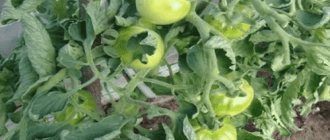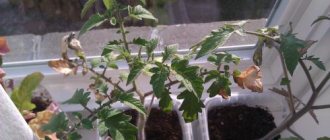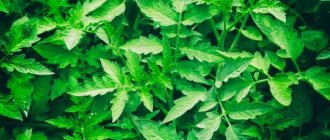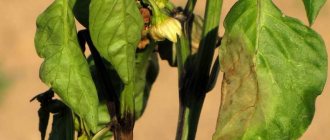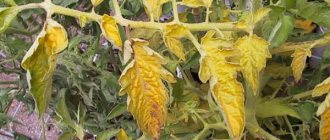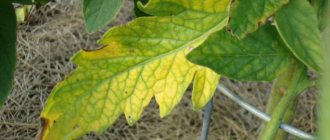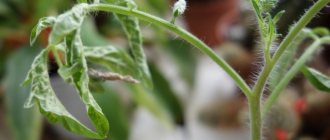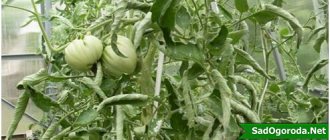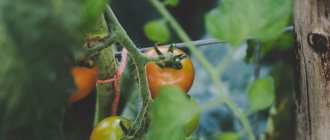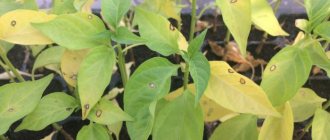Growing seedlings is a mandatory process for most gardeners. She is groomed and nurtured, watered and fed. It’s such a shame when problems happen to plants. The struggle begins for the health of the seedlings, and often for survival. Tomato seedlings are one of the most unpretentious to grow among all vegetables. However, problems arise with it too, and you will have to tinker to achieve the desired result. In this article we will tell you what to do if the leaves of tomato seedlings dry out.
Improper care 1.2. The lower leaves dry out 1.3. Tips of leaves dry out 2. Disease damage 2.1. Fighting with folk remedies 3. Pest damage 3.1. Cotyledon leaves dry
Photo by G. Kuzmitskaya: There are several main causes of the disease.
What is the danger of drying leaves?
A weakened plant that has lost some of its leaves cannot support the full process of photosynthesis. Such a bush experiences a lack of carbon, due to which the ability to build new cellular connections is reduced, growth stops and there is no development of the culture.
What is the danger of drying leaves?
The leaf is a respiratory organ. When the plate is damaged or completely falls off, oxygen does not reach the plant, which negatively affects biochemical processes.
Provide proper care
Any changes in the color and condition of the sheet plates indicate problems
To minimize the likelihood of leaves falling, follow these simple rules:
Provide good sunlight to plants. Tomatoes should be in the sun for at least 6 hours a day, preferably more. This is the only way they can develop and grow normally. If there is a lack of sun in the cells, the processes of photosynthesis are disrupted, they begin to dry out, change color, and in the most advanced cases they fall off. It is best to locate on the south or west side of the house.
Maintain the correct watering schedule. If you carry out work frequently, excess moisture leads to inhibition or even rotting of the root system, plus the likelihood of fungal diseases increases sharply. You need to water no more than once a week and use a lot of liquid; this is the best option for the normal development of the root system.
Properly prepare seeds for planting. If the cause of the leaves drying and falling is a viral disease, then you will not help the plants in any way; they will all die. To eliminate such problems, seeds are disinfected in a solution of potassium permanganate or hydrogen peroxide
It is also very important to select nutritious soil, which you prepare yourself or buy ready-made.
If the leaves begin to dry out or turn white at the edges, then most often the reason is a lack of microelements
- Pick up seedlings. When plants are located in a small common container, over time they inevitably experience a lack of space. The seedlings begin to stretch, the stem becomes thinner, and the plants often shed their leaves - first of all, the lower shoots and cotyledon leaves fall off. It is best to use cups with a volume of at least 500 ml so that the roots have enough space.
- Apply fertilizing if necessary. If tomatoes lack nutrients, it is the leaves that suffer first. There can be many options; it is best to apply complex fertilizer for tomatoes; this is done once a week after picking, then repeated approximately once every 3 weeks. You can alternate traditional and foliar feeding.
- Monitor compliance with the temperature regime. Any sharp fluctuations are dangerous for young plants; high temperatures and bright sun cause burns and drying out of the leaves, and low temperatures provoke a disruption in the absorption of nutrients.
If the plants are damaged by bacteria, it is no longer possible to save them; they should be removed urgently so as not to infect healthy seedlings
The author of the video uses the drug Glyokladin to prevent fungal diseases on seedlings. It is effective and easy to use.
Causes of leaves drying out in seedlings
Even a novice gardener should understand why the leaves of tomato seedlings dry out, what to do to avoid such a situation and begin to restore the weakened plant in time. Otherwise, harvesting from the plantings will be in question. New sowing of seeds cannot always correct the situation - time has already been lost, and no one is immune from a repeated mistake.
Reasons for all the leaves falling off
Green foliage guarantees the health and endurance of seedlings. A change in the shade of the bush, withering and falling of dried leaves are grounds for special attention and search for risk factors. If a problem is detected, it is important to promptly eliminate the negative impact and save the seedlings.
There may be several reasons for the loss of greenery in seedlings grown at home:
- An excess of salts in the soil - the nutritional process of the bush is disrupted, the end of the leaf begins to dry out, and the plant withers.
- A cramped container means the cotyledon leaves turn yellow and wither.
- Dry air - tomatoes are moisture-loving crops.
- Lack of potassium - yellowness appears on the leaf plate, and then the leaf falls off.
- Deficiency or excess of moisture - the soil should not dry out, but stagnation of water is also detrimental to tomatoes.
- Infectious disease - excessive moisture and low temperature can cause the development of late blight. The disease affects greens, stems and fruits.
The main thing is to notice the first symptoms in time, and then understand the reasons.
Causes of drying of the lower leaves
Tomato leaves often dry out along the bottom row. Factors that provoke wilting of the lower foliage are:
Causes of drying of the lower leaves
- Lack of nitrogen - the leaf blade underneath turns pale, young leaves become smaller.
- Excessive soil moisture.
- Lack of lighting - greenery not only dries and crumbles, but also acquires a purple tint.
- Lack of potassium.
Initially, the leaf blade turns yellow, then begins to fade and fall from the bush.
Causes of drying leaf tips
Gardeners often notice that the tip of a plant’s leaf dries out, and the leaf blade subsequently begins to turn yellow and become deformed. Such consequences can provoke:
- Insufficient potassium is a common problem in acidic soils.
- Increased soil salinity.
- Increased dryness of the air - other plants in the house may also indicate this problem.
If the tips of the leaves begin to dry out, this is already an alarming symptom.
The leaves are curling
If the leaves of tomato seedlings become deformed and dry out, restoration work should be done immediately. The problem could mean changes in the climate where the plant grows, violation of agricultural practices and the presence of diseases or pests. Delay may cause the death of all seedlings.
The leaves are curling
There are some varieties of tomatoes for which leaf curling is normal. These varieties include:
- Japanese crab;
- Fatima;
- Honey drop;
- Oxhart.
Tomato foliage may curl and darken due to temperature increases of more than +30 degrees.
White spots appear on the leaves
White spotting or a fungal infection, Septoria, can be a factor in leaf blanching. The disease begins to spread from the lower leaves and gradually moves to the top. The spots have a dark edge.
The second reason why the leaf blade begins to turn pale and become covered with spots is sunburn. When exposed to direct sunlight, the leaves can simply burn. Often, the risk of leaf injury increases on a clear sunny day after prolonged cloudy weather. During the period of solar activity, the seedling box should be removed from scorching rays.
Other reasons for the poor condition of tomato seedlings
Elevated temperatures are the most common reason why tomato seedlings dry out and wither. This often applies to seedlings grown on a windowsill or in close proximity to a window. In such a situation, the pot with seedlings is located too close to the heating devices, and the air is additionally heated by the sun's rays entering through the glass.
Other reasons for the poor condition of tomato seedlings
The second most common problem is picking seedlings. The procedure is performed at the formation stage after the cotyledon of the first pair of leaves. In the absence of proper knowledge and experience, during transplantation the delicate root of the seedling can be damaged, and then the plant will begin to hurt and die.
Fungal and viral diseases
Sometimes the cause of wilting is diseases and pests.
Late blight
Most often, tomato plantings are attacked by varieties of fungal or viral diseases. Late blight is the most common infection. Its characteristic signs include the appearance of brown spots and subsequent drying of the leaves. Typically, plantings become infected during periods of heavy rains and high air humidity.
Prevention and treatment
The disease spreads quickly - all affected areas are immediately removed. The root zone is covered with nettle, as it absorbs moisture well, and the broken areas are treated with a late blight remedy. Sometimes it is better to remove the entire bush to save the rest of the crop.
Tobacco mosaic
Also, the leaves of domestic tomato seedlings dry out due to tobacco mosaic. She appears in mid-summer. As the mosaic spreads, the tops of the tomatoes first wither, then turn brown and yellow. A characteristic sign of the disease is the lacy appearance of the leaves.
Prevention and treatment
In this case, only correct agricultural technology, timely removal of infected plants and correct selection of seeds for the soil can help. Unfortunately, it is impossible to completely eliminate the tobacco mosaic.
Fusarium wilt
Fusarium wilt is another common infection. This is a fungus that feeds on cell sap. The stems turn brown, the leaves fade. With sufficient watering, the bushes look as if they have dried up.
Prevention and treatment
Preventing the disease helps to maintain humidity in the region of 60-70% and thermal conditions, including the use of stove heating if the temperature drops at night.
Pests
Drying of plants can be caused by mites and aphids. For these parasites, the process of sucking nutrients from the body of tomatoes is very important.
Prevention and treatment
For treatment, chemicals are used: acaricides and insectoacaricides. Spraying with a two percent lime mixture or fumigating with a sulfur bomb is also useful if the tomatoes are growing in a greenhouse.
How to save tomato seedlings
After determining the reason why the bush is losing its leaves and withering, treatment should be started immediately. Timely elimination of risk factors will help save plantings and reap a healthy harvest.
When pouring soil
Improperly prepared containers and violation of the irrigation regime can cause increased soil moisture. The seedlings begin to wither and lose leaves. To save the seedlings, the seedlings are transplanted into fresh soil. During the procedure, the root system is inspected for damage and signs of decay. Normally, the roots should be white. If the shade turns black or yellow, the plant cannot be saved.
The soil for seedlings requires loose and nutritious soil. You can make the mixture yourself, but before use, pour it with a saturated solution of manganese or heat it in the oven. This will disinfect the soil and destroy the pathogenic microorganisms present in it. Watering is carried out after the upper level of the soil dries out.
When dry
The leaves of tomato seedlings also dry out if there is insufficient moisture. Seedlings prefer abundant but moderate moisture. In the intervals between watering, the surface of the substrate is loosened for better aeration. During the heating season, install humidifiers or bowls of water. This will prevent the soil from drying out and maintain optimal air humidity.
When the soil becomes acidic
If white or yellow spots appear on the soil surface, this indicates an increase in soil acidity. In such situations, the leaves of tomato seedlings dry out, the plant begins to hurt and wither. Such soil needs to be improved - the top layer of the soil mixture is removed and replaced with fresh one.
To avoid re-acidification of the substrate, the seedlings should be watered with melted water, rain water, or water that has stood for at least 12 hours. Fertilizing is canceled until the seedlings are completely restored.
Lack of nutrients
With poor soil, not only do the leaves of tomato seedlings dry out, but also slow growth and development of seedlings is observed. The addition of additional fertilizers containing a complex of minerals or a specific missing substance will help compensate for the lack of nutrients.
Lack of nutrients
Nitrogen has an active effect on green mass. The lack of an element can be compensated by adding rotted manure (1 liter of mixture per 10 liters of water) or chicken droppings (1 liter of mixture per 20 liters of water).
Additionally, using an aqueous solution of iron chelate will help to saturate the plant with iron - 5 g of dry product per 5 liters of liquid. A folk remedy based on wood ash can compensate for the lack of potassium. To prepare a solution, 50 g of ash is poured into 1 liter of boiling water, and after the mixture has cooled, another 5 liters of water are added.
Using boric acid to irrigate foliage helps eliminate boron deficiency. An insufficient amount of zinc is replenished by foliar feeding with a solution of zinc sulfate - 5 g of the substance is diluted in 10 liters of water. If necessary, the treatment is repeated after 10 days.
Fungal diseases
When grown in a greenhouse or greenhouse, tomato seedlings are often affected by the blackleg disease. This occurs in the absence of regular ventilation and high humidity of the microclimate. The disease can affect not only the foliage, but also the central trunk of the bush. If, as a result of an infection, the leaves of tomato seedlings dry out, the seedlings should be treated immediately, because with every minute the plant loses its vitality. As the disease progresses, the beds are treated with Maxim or Previkur. These drugs stop the development of infection. After recovery, the seedlings must be transplanted to a new location.
Tomatoes can also suffer from brown spot, late blight and septorosis. To eliminate the infection, irrigation is carried out with fungicides - Champion, Ridomil Gold, Quadris and Revus.
If the seedlings stretch
We all want to grow seedlings with a dense trunk, and also a thick crown. But it is important to understand that it is almost impossible to grow such seedlings without the use of special equipment. Moreover, in apartment conditions, seedlings often grow thin and light. Naturally, I want to correct this situation.
In most cases, seedlings can be strengthened by taking the following steps:
- organize more light in the place where you have seedlings;
- reduce the amount of nitrogen and adjust the temperature, it should not be high;
- thin out the seedlings, since often it is the density of plantings that provokes the stretching of seedlings;
- sow tomato seeds no earlier than March;
- make a pick.
By eliminating all these problems, you will ensure that the seedlings acquire an absolutely healthy and natural appearance.
Important: when sowing seeds, use soil marked: for tomatoes. The composition of such soil fully meets all the needs of young animals. Thanks to this, you do not need to carry out additional enrichment with various fertilizers.
In addition, the seedlings are threatened by a disease called septoria, which causes them to become thin and look sickly. The thing is that young animals do not yet have what is necessary to combat immune defects. And if the disease is confirmed, all material will have to be destroyed. However, if you follow all the rules of care and planting, then such a defect will bypass your plantings.
As a preventive measure, spray the seedlings with Fundazol, and water them sparingly. It will protect the culture from many infections of fungal origin.
And one last thing: your seedlings will fully strengthen and become denser in diameter after transplanting into open soil. Therefore, do not panic ahead of time. Just when planting, bury the seedling a little deeper into the ground.
Conclusions about the poor condition of seedlings
In order for the seedlings to form correctly and for the adult plant to take root well in the open ground, it is necessary to expend energy and attention. From the moment the seeds begin to sprout until the development of a full-fledged plant, the crop needs proper and timely care. The state of the greenery can indicate problems. If the foliage begins to dry out, curl up and fall off, this indicates an incorrect microclimate or an infection. If treatment measures are not taken, the culture may disappear completely.
What to do?
If the foliage and young growth dry out, they begin by optimizing cultivation conditions. Check and adjust watering. How to do them correctly:
- Water on schedule 1-2 times a week.
- Water is poured under the root, trying to prevent droplets from falling on the shoots and leaves.
- A spray bottle is used to water the bushes, and hoses and watering cans are used for young and fruit-bearing bushes.
- Use settled, slightly warm water within 22-24 degrees.
- Root feeding is carried out simultaneously or in advance to improve solubility and absorption.
Cold watering increases the risk of infection by fungi and bacteria.
If a young plant is in poor condition due to over-irrigation:
- seedlings are watered with warm water;
- after an hour, remove the plant and inspect the roots for rot;
- healthy bushes are transplanted into containers with updated soil mixture;
- watered with 1% potassium permanganate;
- normalize irrigation.
All bushes with signs of rot on the root system are thrown away.
Diseases caused by pathogenic microorganisms
Such diseases are the most dangerous for plant crops. Can be transmitted through soil, parasites or already present on tomato seeds. Bacteria can manifest themselves either immediately or remain in “sleeping” mode. To avoid plant diseases, you should not allow:
- Temperatures above 28 degrees Celsius.
- High soil moisture.
- Stagnation of water in planting pots.
Reference. To prevent bacterial diseases, do not neglect thorough disinfection of soil and seeds. Any copper-containing solution is suitable for treating seedlings.
The most dangerous bacterial disease can be considered “bacterial cancer”. The disease destroys the vessels of the plant. Externally it appears as:
- The appearance of ulcers along the entire stem trunk.
- Complete death of seedlings.
Treatment is impossible. The diseased plant must be removed and burned. The soil in which the seedlings were located is no longer used. This disease can be prevented by treating seeds with 40 percent formaldehyde (calculating 1 part solution - 300 parts water).
spotting
Buraya
This disease has the following symptoms:
- Small yellow spots on the outside of the leaves.
- Rapid growth of these spots.
- White coating on the inside of the leaf.
- Dying of seedling leaves.
The disease can be cured by spraying cuprosil, copper sulfate or any other copper-containing drug.
Black bacterial
External symptoms of the disease appear quite late:
- Slight lethargy of the sprout.
- Small black spots on the leaves and stem of the tomato.
- Rapid spread of spots throughout the plant.
- Death of a seedling.
It is better to remove infected seedlings. The remaining sprouts must be treated with 1 percent Bordeaux solution every few days.
Mottling
The disease develops due to the penetration of phytopathogenic bacteria into the crop. External signs of the disease:
- The appearance of transparent oil stains on the leaves of seedlings.
- Leaf damage begins from the edges to the middle.
- Curling of plant foliage.
- Complete loss of leaves.
To cure seedlings, it is necessary to spray with copper sulfate (calculating 1 glass - 10 liters of water) or Fitolavin-300.
Stolbur
The most common bacterial disease of home seedlings. The disease is caused by microplasma bodies that are carried by many types of insects. Symptoms of the disease:
- Pink or purple spots on seedlings.
- The leaves and trunk of the plant become very rough.
Treatment and prevention are carried out with any special drug:
- Confidor.
- Aktara.
- Mospilan.
Spraying is carried out twice:
- Three weeks after planting the seeds in the container.
- Before planting seedlings in a permanent place.
Bacterial wilt
A dangerous disease when plants suddenly begin to wither. Other symptoms may include:
- Formation of aerial roots.
- Stopping plant growth.
- Covering the leaves of seedlings with yellow spots.
- Formation of longitudinal brown stripes on the stem.
The disease is incurable. The seedlings should be burned and the soil cultivated. Other plants need to be disinfected with Fitoflavin-300.
The photo below shows a plant affected by the disease:
To get a large harvest of tomatoes in the fall, you need to properly maintain the seedlings in winter. If you care for your seedlings responsibly, you can avoid many diseases.
Preventive measures
How to prevent yellowing:
- If the seedlings are unwell due to waterlogged soil, the bushes are transplanted into a new loose substrate.
- Maintains an optimal temperature of 20-24 degrees.
- If the seedlings are crowded, the young shoots are separated.
- Provide additional LED lighting.
Expert opinion
Valentina Rareko
Editor-in-Chief of Repka.online. Experienced summer resident and gardener.
The volume of the future harvest depends on the quality of the bushes planted. If yellowing occurs, they try to find out and eliminate the problem from the very beginning. Provide favorable conditions and carry out complete, balanced feeding.
Nutrient deficiency
The most important condition for obtaining healthy and strong seedlings is a sufficient amount of microelements in the soil. Seedlings throughout their development must receive a balanced set of nutrients. It is applied during the main tillage of the soil under the beds, as well as during certain phases of plant development.
Acute lack of nutrients is eliminated by spraying with preparations for foliar feeding. In this case, the effect occurs very quickly, since absorption occurs through stomata or tubules located on the surface of the leaf blades.
The main complex of essential microelements for tomatoes includes nitrogen, potassium, phosphorus, calcium, magnesium, sulfur, and iron.
The deficiency of each nutrient is characterized by certain symptoms, knowing which, you can regulate their intake:
- Nitrogen deficiency is noticeable in the early stages of growth. Without this microelement, normal development and fruiting of tomatoes is impossible. The main symptoms are curling of the lower leaves and a significant lag in plant development.
- Phosphorus takes part in the formation of the root system. Its deficiency reduces resistance to disease. Deficiency manifests itself in the curling of leaves and the appearance of purple veins on the underside of the leaves.
- Potassium forms immunity, affects the taste of future fruits, and increases their keeping quality. Symptoms of deficiency include shredding of leaf blades, curling and drying out at the edges, and the appearance of rust.
- Calcium is involved in growth processes and the formation of the root system. The trace element stimulates the development of roots. Symptoms of deficiency are the appearance of characteristic opalines and light spots on the leaves.
- Sulfur is involved in oxygen metabolism. With its deficiency, plant leaves wither and become brittle.
- Magnesium takes part in the process of fruit formation. The deficiency manifests itself as follows: the lower leaves bend in the shape of a “house”, dry out at the edges, and begin to fall off.
- Iron deficiency is especially noticeable in the early phase of development and at the flowering stage. A characteristic yellow border forms on the foliage of the seedlings.
Preventive measures
Any disease, even if it concerns plants, is easier to prevent. A number of preventive measures will prevent the leaves of the seedlings from turning yellow and the seedlings themselves from withering and dying.
- Buy quality seeds from a manufacturer you trust.
- Choosing high-quality soil is no less important: if it is infected with a fungus, it is unlikely that it will be possible to prevent the plant from becoming infected.
- Learn the rules for caring for tomato seedlings, their whims and preferences, and take care of them correctly.
If these measures are taken, then you most likely won’t have to look for answers to the questions of why tomato leaves wither and what to do to save them.
Having noticed that tomato seedlings are withering in a greenhouse equipped with the latest garden technology, there is no need to bury the future harvest in advance. There is no need to panic, even if a significant part of the tomato bushes are dying before our eyes. There are quite a lot of chances that the entire crop will not be lost.
There is no clear answer to the question of what to do to revive seedlings and prevent them from withering completely - it all depends on why the plants feel so bad. Most often, the reasons lie in improper care or the presence of a fungal infection that has affected the plants. Effective measures can be taken in any of these cases. If you do everything correctly, you will definitely reap a harvest of tomatoes, even if not as large as you expected.
